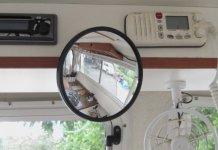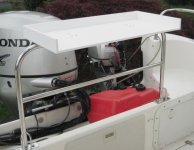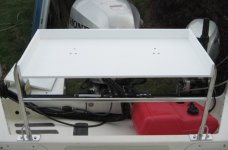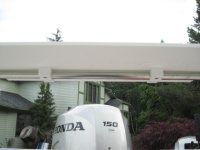Pat Anderson
New member
- Joined
- Nov 2, 2003
- Messages
- 8,562
- Reaction score
- 0
- C Dory Year
- 2005
- C Dory Model
- 25 Cruiser
- Vessel Name
- Daydream
First, we have wanted a rearview mirror for some time, opted for an "off-the-shelf" solution - this is a 6" convex mirror from Grainger. It is on a ball swivel, so easy to adjust for helmsman to adjust. It was easy to lag screw to the underside of the radio shelf just as it came out of the box.

The biggie, though, was installing our brand new motor well rail from Railmakers, building a Starboard table, and clamping our new table on the rail.



We got 3/8" Starboard at Tap Plastics in Bellevue, they cut the table to 30" x 14" and then cut the back and side pieces as well, fit perfectly. They told us there is no glue in the world that works with Starboard, so we just used screws. It is all screwed together with #6 stainless screws. The rail clamps are from West Marine. I still need to chamfer the edges, but otherwise that is it.
Learned a bit. We should have used either 1/2" Starboard or #4 screws, because the Starboard is bulging out where the screws go into the 3/8" side. If we do another table, it will be 1/2" Starboard, and we will have them round the corners. I also need to buy some countersinks, the flat head screws do go down into the Starboard, as it is really fairly soft, but it would have looked a lot nicer if I had used a countersink.
Not saying this is necessarily a practice run, and we will probably use the table this year, but I think I will probably do another one with the thicker Starboard and a little nicer construction some time in the future, But for now, this is a huge amenity we have been wanting in the cockpit, and think it really will be dandy!

The biggie, though, was installing our brand new motor well rail from Railmakers, building a Starboard table, and clamping our new table on the rail.



We got 3/8" Starboard at Tap Plastics in Bellevue, they cut the table to 30" x 14" and then cut the back and side pieces as well, fit perfectly. They told us there is no glue in the world that works with Starboard, so we just used screws. It is all screwed together with #6 stainless screws. The rail clamps are from West Marine. I still need to chamfer the edges, but otherwise that is it.
Learned a bit. We should have used either 1/2" Starboard or #4 screws, because the Starboard is bulging out where the screws go into the 3/8" side. If we do another table, it will be 1/2" Starboard, and we will have them round the corners. I also need to buy some countersinks, the flat head screws do go down into the Starboard, as it is really fairly soft, but it would have looked a lot nicer if I had used a countersink.
Not saying this is necessarily a practice run, and we will probably use the table this year, but I think I will probably do another one with the thicker Starboard and a little nicer construction some time in the future, But for now, this is a huge amenity we have been wanting in the cockpit, and think it really will be dandy!
